Detailed booking records reflect Packages and options purchased, payments due and received, and other data related to the booking.
The booking process usually begins in the Client database, where your first order of business is to find (or create) the Client record to which the booking is to be linked. As appropriate and if you haven’t already done so, address the question of whether the reservation will be for a group leader or re-seller, in which case it should be marked as a Master; whether (at what percentage) the reservation should be commissioned (Address tab) and whether a salesperson is to be credited with the booking (Main tab). So long as the Client record is “Active”, you are good to proceed.
Making a Booking
Let’s look first at making an individual, direct booking. Instructions for creating a GL will follow later.

In the first screen that presents, you will see and be able to select from codes for all tours still to depart and marked active. Otherwise, if you know the code, beginning to type it will narrow the search.
Once having picked a code, glance to the bottom of the screen where the tour name, begin and end dates will have dropped into view. You will also see a display of the tour’s present status—number booked, available, etc. and, just below, the name of the Client or Contact to which this booking is linked.
Using the value lists that present, complete the # Travelers, the Type of Room (if it’s a day trip with no room component, choose “Day”), the Type of Booking and the Type of Invoice fields. When creating a “direct” booking, i.e. not associated with a group leader, travel agent, etc., your input will be “PAX” and “PAX”.
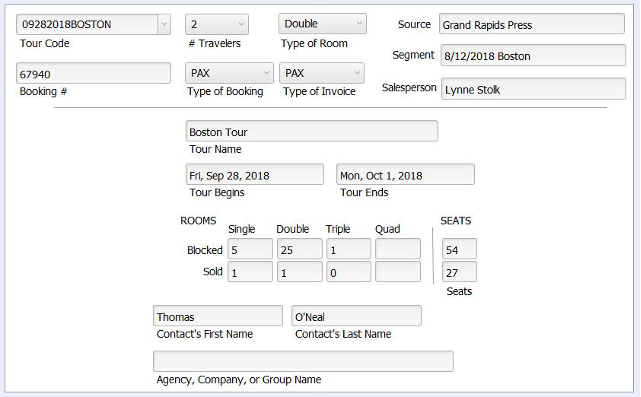
If you’ve made an incorrect selection, simply select again. If you need to thwart the booking process because you’ve started from the wrong Client, or for any other reason, click on the “Stop” button.
Click on the “Continue” button to move to the next window.
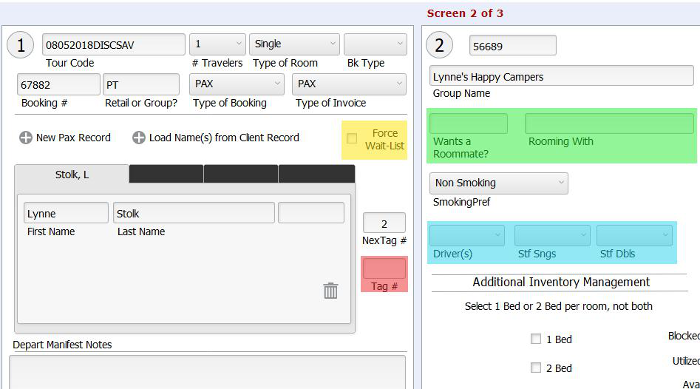
If for any reason you want to manually waitlist the reservation, click the box highlighted in our example in yellow.
If the reservation is for a single person open to sharing a room, click in the “Wants a Roommate” field.
If the traveler has a roommate, confirmed in a separate Booking, the roommate’s name can be entered in the “Rooming With” field (see green highlights) and you can now, or eventually, mark both records with a common Tag #, explained as follows:
Each time you make a booking, TourTools™ will automatically assign the next available Tag#, shown in our example as #2 in the field labeled “Next Tag #”.In some sense, tag numbers can be thought of as room numbers and are what allow you to tie reservations from separate records together on the rooming list. You are able to manually assign or override a tag number (in the field highlighted in red), either now or at a later time, to travelers who have separate booking records but plan to share the same room.
Example
Harriet Smith and Betty Jones have two separate client records and are rooming together on tour. Harriet’s reservation was processed first and was automatically assigned tag number 5. Two weeks later, you receive Betty’s reservation. If you note Harriet’s number before processing Betty’s reservation, you can immediately enter “5” in the tag number field as you book Betty; or, once Betty’s reservation is complete, you can go back and override the number that was automatically assigned. The shared tag number is what will join them on the rooming list you will eventually generate.
A few suggestions: The rooming list’s primary sort is on the Tag # so it is recommended that you assign a high number to the driver and tour escort; that way, they will drop to the very bottom of the document. It may also be helpful to assign sequential tag numbers to all of your double/twin rooms, then follow with your triples, then quads, then singles. It makes your roomlist a little more logical and visually appealing. Finally, it also makes sense to assign sequential tag numbers to people traveling together, who have requested adjacent rooms.
If the reservation is for a Driver or someone (an escort or group leader) you consider to be Staff (traveling on a Single or Double occupancy basis), click in the appropriate field (in our example, highlighted in blue) to load the number of passengers in the record to be tagged as such. Note that the numbers entered in these fields are what will populate the “Utilized” fields of the same names in TM.

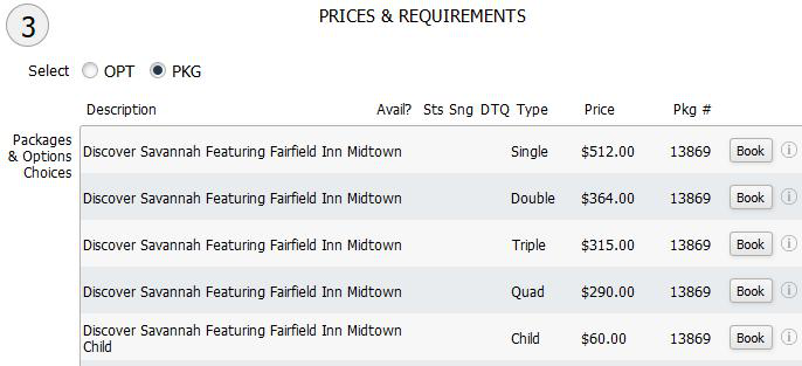
Referring to the example on the previous page, since the booking is for one person in a single, the “Discover Savannah” package on a “Single” basis would be selected by clicking on the “Book” button on the right. Once a selection has been made, the Package details will load below, along with an indication of how many passengers booked the service, and the status. In our example, since the “#Travelers” in the record was 1 when Discover Savannah was booked, a 1 would drop into the “#Pax” field. If the sale is confirmed the Status will show as “CNF”, the Price field will reflect the per person cost of $512, and PKG shows as the Type. If there is no space available on the tour, either because the capacity reflected in TM has been exceeded or because inventory in one of the Package’s Price/Inventory records has been depleted, the Status will display as WL (waitlisted). Note that any and all waitlisted records remain so until you clear them; i.e. the process is not automated meaning you might chose to confirm the second or third record ahead of the first if circumstances dictate.
As mentioned earlier, if there are other package types associated with the tour, additional buttons (labeled OPT, LAND ONLY, etc.) will display. Click on them one by one and examine each list to make all the appropriate selections for your Booking. If you are not certain which Package is the one you want, clicking on the small “i” icon next to the Book button, will take you to the Packages module, where you can view the itinerary to see what is included, before returning to the Booking.
The last thing to reference on this layout relates to the traveler’s departure preferences, as they relate to motorcoach or air travel. If noted in their Client record, those preferences will be visible here. If a schedule of motorcoach pick-up and drop-off points has been loaded in TM, that detail will also be visible and available to select from.
To proceed to the next step in the booking script, again click on the “Continue” button at the top of the screen.
You are now at the point where a payment can be posted. Click on the “New Payment or Discount Record” button to post anything but automated credit card payments (possible if TourTools™ is interfaced to an internet-based credit card processing software; process explained below).
The Type of Payment is a value list of choices (Cash, Check, Credit Card, etc.), the check number goes in the field so labeled, the initials or name of the person posting the payment should be entered in the Received By field, today’s date will auto-fill in the Payment Date field, free-form notes can be entered in the Transactions Notes field, and the amount of the payment should be entered in the Amount Paid field. If your system is programmed to accommodate the sale of travel insurance, there is a field reflecting the premium due as well as a field where the amount of the premium paid can be input. Note that the only time you will use the Credit Card identifier as part of this process will be in instances where you ran the card outside of TourTools™ and need simply to add the payment to the record after the fact.
If you want TourTools™ to calculate a discount based on a percentage of the total cost, select “Discount” as the Payment Type and input the percentage as a decimal (example .10) in the Discount % field and click on the “Calc Discount” button. At that point the calculated amount will drop into the Amount Paid field.
When all entries are complete, use the “Post”
Credit Card Payments and Voids
To process a credit card payment online, click on the “Credit Card Payments” button and then on the “New” button.
Doing so will begin to set up a payment record and will “auto-load” several fields; today’s date, and the Client name.
As appropriate, click on the “Bal” button to load the current balance, and pick from the value list to identify the Payment Type. Do the same in the CC Transaction Type (Sale, Credit or Void) field, and continue by entering the card detail. If you have the security code, load it in the field labeled ID. This number is not vital to the process unless required by your credit card vendor.
When all entries are complete, click on the “Submit” button. Upon receipt of an authorization response, you will be prompted to post the payment to the account.
If you need to void a payment, click on the “Void” button that appears beneath the entry on the “Payments” screen. That will queue up the details of the card, the amount, the authorization code related to the payment, etc. related to the payment that needs to be reversed. Follow the prompts to continue. Note: A payment can only be voided on the same day it was initially processed.
The reservation process ends at the Notes screen. Notes entered in the Depart or Ret Manifest fields will appear on the manifests that reflect who is joining and leaving the tour at points specified in the Tour Master record and picked in the Booking (further details follow). Airline Notes will appear on the various flight manifests; Invoice Notes will appear on the Invoice or Receipt, and Rooming List Notes are self-evident. To make internal notes about the Booking, type in the unlabeled white field and click on the pencil to load. The remarks will be tagged with the current date as well as your name.
The “required steps” in the booking process have been completed. You may now need/want to click to some of the other tabs in the record to make additional entries.
Completed Booking Screen
Most of the fields/buttons on the top of this layout do not require explanation or have been addressed previously. Those that haven’t include:
Tag Color: In cases where you have a multi-bus move and want to assign travelers to one bus or the other, use the color coding available via the value list attached to this field (this is different than the colors you are able to assign to bus pick-up and drop-off locations in TourMaster).
Go Pax Records: For every name in the Booking record, there will be a corresponding “Pax” record, accessible by clicking on this button. You’ll recognize the fields in the section labeled “Personal/Dietary Information” as referencing data from Client (Passport Number, Birthdate, Medical Conditions, etc.). If these fields were empty at the time the booking was made, go back to the Client record to load the details, then return to the Pax record and click on the “Update Health/Diet Info from Client”. You can otherwise update or edit the information right here; however, your input does not translate back to Client.

Along the top of the screen you will see a bank of buttons that can be used to generate a variety of name and also luggage tags, as well as a label that can be used to tag document packets.
Use the “< Back” button to return to the front page of the Booking.
Clicking on the small spoon and fork icon has the same effect as clicking on the “Go Pax Records”. If meal selections have been loaded in TM, notice that the icon will turn red or pink.
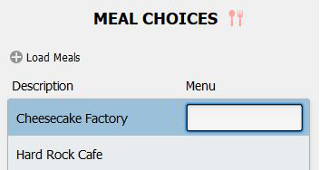
At the bottom of the Pax screen there are fields referencing Fundraising and Insurance, both of which are not generic to the system. If either might be something you can use, please ask for details.
Payments Tab
This is where payments received after the Booking record was initially created will be posted. In the center of the screen is a display of the payment requirements as established in the TM record, along with a running account of what is currently due. Clicking on the “Load TM Deposits” will update the record with details from TM, which detail can be overwritten as necessary if you make special payment arrangements with the traveler(s).
The “Passenger Invoice” pane running along the right side of the record will display in more detail a breakdown of charges—including any charges posted in the Direct Entry Option (sub) tab on the Prices tab and any air charges from the Flight Info tab—as well as any payments, commissions and such. This display is different when looking at a GL/GL record.
“Credit Card Passthru” is one of the values that can be assigned to a payment and will be selected in instances where you pass your traveler’s credit card information on to another vendor—such as an airline or cruise line—in payment and they, rather than you, do the actual processing. Note: Don’t forget to make corresponding entries for payments processed in this manner to the Vendor account payable in Ops.
If you have situations where you need to transfer money from one Booking to another; use the “Transfer” payment identifier. In the booking record that you want to take the money from, enter a negative figure in the “Amount” field and reference the record to which you are transferring the money—perhaps by last name and booking number—in the “Transaction Notes” field. In the record you are transferring money to, you will also indicate “Transfer” as the type of payment but will enter a positive figure. In the notes field, again reference the name and booking number from where the payment originated.
In the area to the left, note the two buttons “Block Pay Remind?” and “Block Late Remind”. By default those are set to “No”, but can be set to “Yes” if the traveler is to be notified via email of delinquency or a payment deadline coming up (part of the TourTools Online interface you may have purchased).
A couple of things to mention regarding payments. You’ll notice an “up arrow” precedes each payment in the portal (this is the same in Ops). As always, that is an invitation to “click for details”, and the “Payment Entry” that presents contains all of that detail. Modifying or deleting a pay record should be done only in extreme cases, usually at the discretion of the owner, as this goes against all accepted accounting procedures.
If you have a returned check, do not delete it as doing so means you lose the payment history. Rather, make an adjusting entry by posting a new payment with a negative amount equal to the value of the bounced check, and in the transaction notes field reference the fact that “this replaced returned check #xxx”.Pre-Scheduled Credit Card Payments
If you have agreed to a traveler making regularly scheduled credit card payments against their balance, there is functionality to accommodate and somewhat automate that. For details on the process, contact your TourTools™ support person.
Prices Tab
This screen shows the Packages and Options available (at the bottom) and sold (at the top).
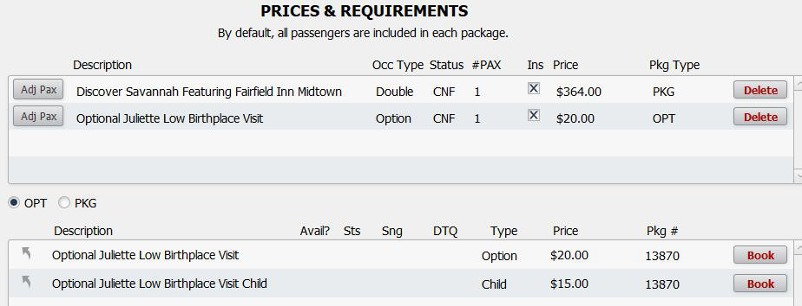
You can add to or take away from the booked packages and options here. If the travelers in this record, by example, change their mind about wanting the optional Juliette Low Birthplace visit, you would click on the “Delete” button associated with the Package.
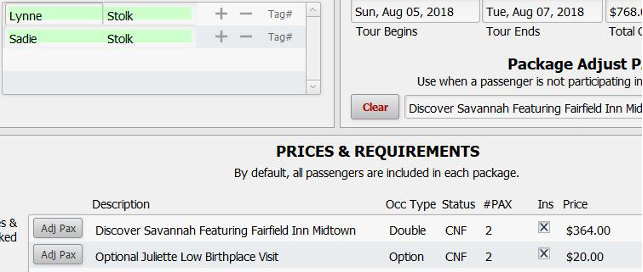
It is possible to tie two travelers from separate records who are going to room together on an optional post-tour Package together by typing a common “Tag#” in the field so named. Note that this is a different tag than the one associated with the base package confirmed in both of their Bookings.
Example
Wilma Flintstone and Betty Rubble are traveling with their husbands on a tour that offers an optional post-trip extension. The Flintstone booking is assigned tag #1, and the Rubble, #2. In the Flintstone record, Wilma is shown to be the one Pax confirmed for the post-tour by virtue of the green highlighting; and in the Rubble record, Betty is similarly shown to be confirmed. In the field labeled “Tag#” that follows their names, typing a 10, by example, will assign them that position on the roomlist that will eventually be run for the hotel featured in the post-trip extension.
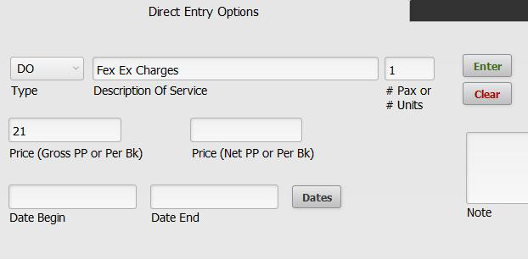
Flight Info Tab
On the Flight Info screen, there are three tabs. If you have flights loaded in the TM record, clicking on the one labeled “All Flights by Tour” will display those for selection.

You can otherwise build a flight itinerary for an individual traveler or for the group right here in Bookings; the process is exactly the same as explained in Chapter 4, and in fact the new itinerary will be saved to the TM record.
To press a point as concerns the “Fare” field, this amount should be loaded in one segment related to the itinerary to reflect the associated cost. Be aware that this fare will add to the balance due being calculated in the Booking and thus contributes to the overall “Tour Gross” amount as reflected in the P/L for the tour. What is not accounted for here, however, is what you paid the airline. As such, unless you account for that by means of a Price/Inventory record linked to and sold as part of a Package, or make a miscellaneous adjustment in Ops, your profit will be overstated .
When it comes time to assign a flight schedule to a specific Booking or to a found set of records, click on the “All Flights by Tour” and make the selection appropriate for your traveler(s) by clicking on the “Book” button. The script will ask if you want to book by “Segment”, sort of a la carte; or, use the “Itinerary” color, which would load the complete itinerary from start to finish. You will also be asked if you want to load to just the record you are in, or if you want to load to your expanded “found set”. Whatever your selection, the flight itineraries will load to the Booked Flights tab.
If you have a schedule change or change in the cost for the air transportation, go to the All Flights by Tour tab in Bookings or in TM, and click on the “Edit” button in the segment you want to alter. Make whatever change is appropriate in the window that displays and click “Save” to complete the update in the record and in the records of all passengers holding the segment in question.
If you have a schedule that is similar to one that is already in the flight library, you can click on the “Edit” button and in the window that opens use the “Duplicate” button at the top of the screen to make a copy of the itinerary. Then, open the new record—again using the “Edit” button—and make whatever changes are necessary before saving it.
The Reports Menu section at the end of this chapter details the air manifests that are available from here in the Bookings module. Be aware that clicking on the “DEP” and “ARR” buttons on the “Booked Flights” tab in any individual Booking will allow a “quick call” of a manifest for tour participants on just the segment represented.

Group Booking Tab
The process of making a GL booking is explained in detail later in the chapter.
Group/Agency or Company Information: If the Booking was made via a GL record, the Group Leader’s Client number will be referenced in the GL Rec # Cli field. The field GL Rec # TM references the link between the Booking and the Master record that may be associated with the TM record. Clicking on the button labeled “Find Group” will assemble all of the Booking records related to the same GL for the same tour and will also reference how many there are in total.
Gift Package Description. Use this area to load the cost for gifts that are purchased by a second party for the traveler(s). By example, the children of some cruise participants want to surprise their parents with a fruit basket in their cabin. You can load the description and the cost detail and log the date you received payment. None of this information affects the balance due, does not appear on any invoice or confirmation, and does not impact your P/L.
Departure Tab
If a “Preferred Departure Point” was loaded in the Client record when the booking was made, you can reference it here as you view the pick-up and drop-off spots that have been established for the tour back in TM. Select on behalf of your traveler(s) by clicking on the appropriate “Load” button. Should you offer the option of a home pick-up, click to pick the “Home” button on the left-hand side, where the traveler’s home address from Client will be visible. If they are being picked up at an entirely different location, pick “Other” and load the specifics just above.
Refunds Tab
If a refund is payable due to an overpayment or due to cancellation of a reservation, come to this screen to see the detail and to close the account. In the case of a canceled reservation (details on the process are explained later in this chapter), the display might look something like what you see here.
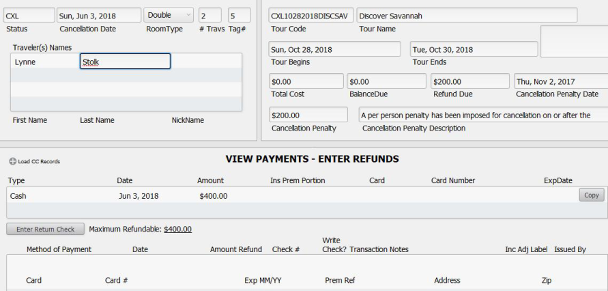
Clicking on the “Enter Refund Check” button will load the refund payable and at that point the “Refund Due” will zero out. Posting the refund in the lower section of the screen is exactly like posting a payment.
If the refund is to be made via credit card, click on the button labeled “Load CC Records” (directly to the left of the “View Payments – Enter Refunds” label) then on the “New Credit Card” button and then enter pertinent card details as is done when posting income. The payment type will be identified as “Refund” and the “CC Trans Type” will be “Credit”.
Note: It is possible to override the penalty that calculates automatically from Tour Master. In this case, if you decided to penalize the travelers just $100, you would overtype the $200 “Cancellation Penalty” and the “Refund Due” would adjust to $300.
The “Refund Letter” that can be generated from the Doc Queue tab of the Reports menu will display all of these figures on a document that can be mailed, along with your check, to the passenger.
Refunds due to overpayment are handled in exactly the same manner. All refunds pending in your system can be viewed on the “Refunds Due List”, another report that can be accessed from the Reports menu.
Commission Tab
If commission percentages were loaded on the Addresses tab in Client at the time the Booking was made, commissions will have automatically been calculated on sales of “Top” or “Level 2” Packages. In this example, the top commission level in the linked Client record was set to 10% and on a $364 Package, the commission due is $36.40. Any Packages identified as “2nd level” would be commissioned at 5%, as would any air, options, etc. (in our example there were none).

You can manually add or manipulate the commission figures as needed. In this example, if you wanted to round the commission to an even $37.00, enter .60 in the Comm Adj field. If you wanted to round downward to $36.00, your entry would be -.40. Use the “Comm Adj Description” field to enter an explanation as to why an adjustment was made.
TourTools™ queues the commission due, to be paid on the return date of the trip. You can override the calculated date by changing it in the Date Due field. The “Commission Due List” report will give you an overview of these payables.
When you are ready to settle the commission, click on the “Enter Commission” button. The date and the amount of the commission will drop into the appropriate fields, and the Type of Adjustment will automatically be tagged as “Commission Retained” if there is still a balance outstanding on the account. If the account has already been paid in full, the type will be identified as “Commission” and the transaction will be settled upon entry of a check number.
Address Tab
This screen references the address and contact details loaded in the Client record from which the booking originated. If that record represents the traveler, the “Client Link” tab will be populated. If the Client is the “Master” or is linked to a Master, then the “Group Leader Link” tab will show that detail.
If the Booking should have been—but wasn’t—linked to a master at the time it was made, you can establish that relationship retroactively by simply typing the Master Client’s Record ID number in the field labeled Agent ID # on the Group Leader Link tab. You can toggle between the Booking and the GL Client record by clicking on the “<GL Agent” button at the top of the screen. Clicking on the “< Client” button will take you to the traveler’s Client record.
Res Status Tab
Click on this tab for a general overview of pertinent details of the record.
To Do Tab
The Bookings database is one of many from where you can create “To Do” records. For specifics, see Chapter 9.
As documents like confirmations, invoices, etc., are printed from the record, they will list automatically in the To Do portal.
From the “Documents” sub-tab, documents associated with the Booking can be linked and viewed. The functionality is the same as explained in Chapter 2 and again, later in this chapter.
Making a Group Leader Booking
So far, what we’ve covered is the process for making a reservation for individuals who are booking direct and paying their own expenses. In situations where you have a sponsoring organization or another reseller acting as an intermediary, you will set up what is referred to as a Group Leader booking record. GL records can be used in situations where you never actually receive the names of the travelers— perhaps for a day trip—and it will suffice to simply invoice for “x” number of travelers; or, for instances where you receive nothing more than the names of the travelers, for whom there’s no need to create an individual Client record, and a summary invoice is desired.
The process of creating the Group Leader record begins exactly the same as for an individual, i.e., start in the Client record— which must be identified as a Master —and click on the “+ Booking” button.
Once in the new Booking record, select the tour code and skip over the “#Travelers” and “Type of Room” fields. Select “GL” as the “Type of Booking” and “Type of Invoice” and then “Continue”.
On the next screen, no pax name is entered in the record. This type of Booking can be thought of as a “holding account” or a “shell record”.

This process can be repeated for as many packages as you have available and wish to sell and set up for invoicing. By example, if on this tour we needed to also invoice for 9 persons in a triple and 12 in a quad, we would repeat the process of selling twice more. When you finish, the Prices tab will reflect the sale of 4 Doubles, 9Triples, etc., and the “Group Leader Invoice”, that can be run from the Reports menu, will detail these charges.
If, as promotion of the trip moves along, there are changes in the numbers of passengers expected to travel, you can return to the Prices screen and click on the number currently confirmed for a given Package. The same window as shown earlier will open, and you can simply overtype the numbers.
If the record created in the early stages was to hold seats and allow creation of a pro-forma invoice, and you now have actual names of the travelers, come to the Prices screen, and delete the number of Package(s) sold. What you are doing is, in essence, releasing seats back into inventory in order that you can scoop them back up in the name of “real” travelers.
The process described next is used when you’ve been given the traveler’s names by the group leader and are ready to book them.
Begin by creating a GL/GL record as just described but move past the Prices tab without selling any Packages. Instead, complete the record, return to the Group Booking tab, and click on the “+ Make Another Booking for This Client or Group” button.
You will immediately be asked if you want to “Include” or “Separate” charges for this booking on/from the GL/GL record. Nine times out of ten, you will “include”, meaning all charges will be swept to the GL record, which is usually appropriate. The rare exception is addressed on the next page (notice the asterisk that appears toward the bottom).
The screen that you see next is a compilation of the main Entry screen and the Prices layout. Enter the #Travelers and Type of Room, then click on the “+New PAX Record” to enter the name(s) of the travelers. You’ll see that the Type of Booking has
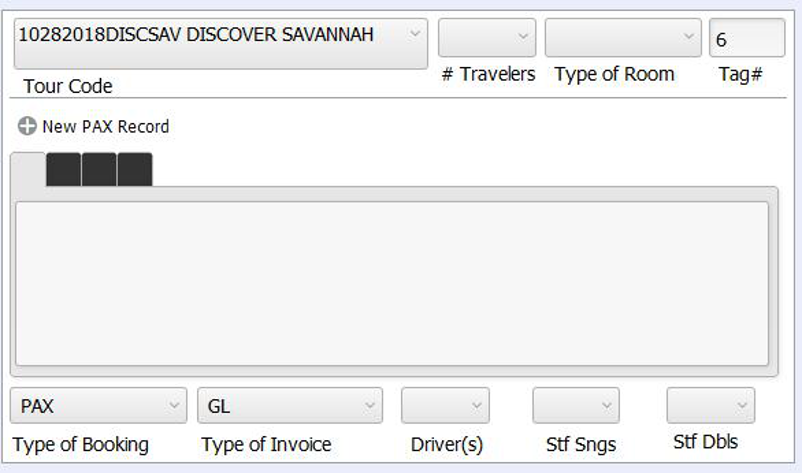
been identified as “Pax” and the Type of Invoice “GL”; values you will not change. After entering names in the record, proceed to the selling of a Package or Packages below. When you are finished, click on “Another” to continue adding passengers, or on “Done” once you have entered all of your group names.
The individual Booking records thus created will reflect Package sales on the Prices tab but appear to have no corresponding balance due. What is happening is, the cumulative total of all charges for all (*) bookings is being swept to the GL/GL holding record. This includes the cost of all Packages plus any “Options” sold on the Group Booking tab.
Some things to remember about Group Leader holding accounts:
If the group leader is actually traveling, it is recommended that the first Booking you make from the GL holding account be theirs. Remember that the holding account—the GL/GL record— is just that; it is not a reservation record for any individual.
Unless your group is being billed outright for a tour manager and driver, reservations for those personnel will be PAX/PAX made direct, in other words, not via the GL holding account.
All financial transactions+—including the posting of income and the payment of refunds or commissions—+must be made in the GL holding account (*) Nothing of this nature should be posted to the individual booking records. Even if checks are received directly from a traveler to pay for an individual service—an airline ticket or some optional expense, by example—if they are booked as Pax/GL, the payment still gets posted to the GL record. In such a case, the “Transaction Notes” field would ideally reference the payee.
As a reminder…If you generated a pro-forma invoice and then receive actual names from your group leader, remember to go to the Prices tab in the GL record and delete the preliminary sales you made before entering the names as actual sales. This will prevent your creating your own overbooking situation.
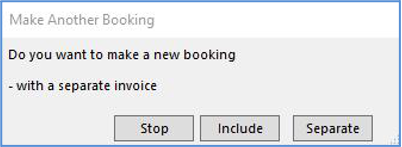
At the point you begin the process to “Make Another Booking for This Client or Group”, you are asked if you want to Include or Separate the charges from the GL Invoice. If you have a situation where an individual traveling with the group is going to make their own payments on account, indicate that you want to separate them out. When you do, the invoice will still be addressed to their Group Leader, but the document will be completely separate from the GL Invoice.
Canceling or Rebooking an Entire Booking Record

Canceling One Passenger in a Record
To the right of each Pax name listed on the front page of a Booking record, there is a small trash can. Use that when one of the passengers represented in a multi-traveler booking needs to be canceled. When doing so, keep an eye on related data in the record; by example, has the number of travelers reduced from 2 to 1? Should the Package confirmed no longer be “Double” but need to be adjusted to “Single”? To be sure, not all of those changes will happen automatically.




Insurance
The sale of insurance can be automated (consider customization) in TourTools™, and throughout the system you will see fields and layouts that reference coverage. The specifics of what you sell and how you sell it will need to be programmed, and separate instructions for managing your program will be provided upon completion.
Reports Menu
Since there are so many reports and documents available in the Bookings database, they are divided over five different tabs, as follows:
Doc Queue Tab
On the left-hand side of the layout, there are buttons representing the various documents that you send to your travelers. These may include confirmations, receipts or invoices; or may be forms that need to be completed and returned to you.
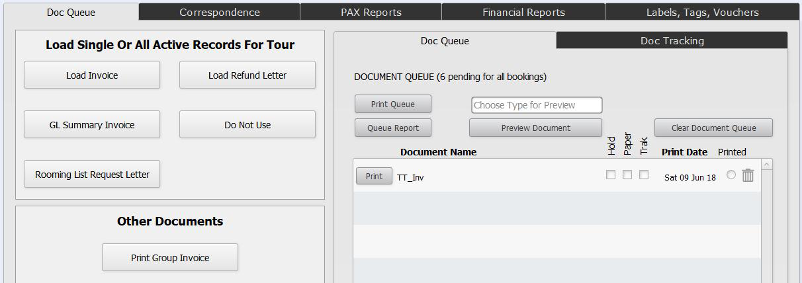
A single click on a button will send the document in question to the document queue on the right. If you wish, all documents queued up can be run at the same time by clicking on the “Print Queue” button (any you want held back temporarily can be marked “Hold”, which will prevent their printing). If preferred, single documents can be run by clicking on the “Print” button preceding the document’s “name”.
If the Client record to which the Booking is linked has an e-mail address, the document can be e-mailed, or it can be printed to paper; you will be given the choice when you click on the “Print” button.
If you are going to run a batch of documents from the queue, be sure to click in the box labeled “Paper” for any registrants who have e-mail but don’t want to receive their documents electronically. The process is completely automated, meaning the e-mail/paper choice will not be presented for each individual record.
As soon as the document is sent, the Print Date will auto fill, and the button labeled “Printed” will highlight. If there is a need to re-print, de-select the button by clicking on it and the document will go back into the queue, and/or can be manually reprinted or emailed.
If you have documents that need to be tracked—in other words, they need to be returned to you by the traveler (liability release forms is a good example)—click the “Trak” field before you print it.. Once the form is returned, record the date on which that happened in the Recd Date field on the Doc Tracking tab.
Click on the trash can icon to remove a document from the queue.
The other buttons in this area include the “Queue Report” which will generate a report showing everything that is in the queue; and the “Clear Document Queue” button which will clear the queue completely of any documents that have yet to be printed. Click in the field Chose Type for Preview to select the document you want to look at, then click the “Preview Document” button to view it.
Correspondence Tab
Group Leader Invoice: This is the invoice you will send to your group leader. The individual travelers linked to the GL/GL record are listed on the form, as are all charges and payments that have been swept to the GL account. If you prefer to send a summary of charges without all of the detail, run the GL Summary Invoice from the Doc Queue tab.
Unstored Fax/Unstored Letter: Use as a means to send a quick note or fax to one traveler or all passengers on a given tour. As the name implies, these are not permanently stored anywhere in the system; each time the form is used, you overwrite the text that was entered the last time.
Pax Reports Tab:
Rooming List: A list of all passengers confirmed on the tour, sorted on the tag number. Be aware there is another roomlist that can be generated from Ops, which is Vendor specific.
Rooming List Internal: Same as above but including some additional information about the travelers that might be helpful to the tour manager.
Ticket List: If your system has the “Ticket Module”, this report lists who is assigned what tickets.
Passenger Address List: Lists the names of all passengers on the tour, along with their addresses.
Cruise Dining List: This report displays the dining preference and dining notes loaded on the main entry screen in the Booking record. Dietary preferences loaded in the Client record are also referenced.
Passenger List: A list of travelers by name, also showing their Booking numbers.
Passport Report: This report displays the passport details, birth date and other information stored in Client.
Pax Meal Report: Information regarding your traveler’s menu selections are reflected on this report.
Waitlist Report: When this report is called, you are given the choice of listing passengers waitlisted on all tours or just the tour that shares the code of the record you’re in.
Special Occasion Report: Reflects information loaded on the main entry tab, having to do with special occasions being celebrated while on tour.
Insurance Report: Will be activated if and when your system is customized to accommodate insurance sales.
Universal Manifest: Reflects names, addresses, birthdates and passport details.
Departure Bus Manifest: Use this report to see “who’s getting on where”, based on input made on the Departure screen. The $$ appearing to the left of the passenger name indicates that the traveler still owes you money.
Return Bus Manifest: This report is identical to the outbound manifest only showing the return day information.
Master Dep Manifest: A variation on a theme, this report lists passengers, their home phone numbers, and notes on where they are boarding the motorcoach.
Air Manifests: When you call this report, you are given the option of displaying data by “Pax” or by “Segment”. If you chose “Pax”, each individual traveler and their schedule will list; if you pick “Segment”, all travelers on a specific itinerary will display as a group.
Air Manifest – by PNR: This report reflects all passengers on a given tour who have flight itineraries confirmed, sorted by PNR record.
Financial Reports Tab:
Booking Totals B/O/C Status Report: This report lists passengers by tour, offering an indication of whether they are Booked, Optioned or Confirmed; also showing total charges, discounts, total paid and due, and cumulative totals.
Booking Totals Report: This is a list of tours, arranged in order of departure date, showing the number of passengers booked, total sales and total paid, as well as balance due. Cumulative totals appear at the bottom.
Balance Due: This report can be run by a specific date, date range or tour; and shows where there are balances owing.
Cash Report: This report can also be run by a specific date, date range or tour; and shows all payment activity. Even though it is called “cash” report, payments by check and credit card are also displayed.
Credit Card Report: This report is identical to the “Cash Report” as far as how it is called and what it displays; however, it displays only payments identified as “Credit Card”.
Late Payment Report: This report shows those individuals who are late with payments, comparing the payment history of the Booking to the deadlines loaded in Tour Master.
Refunds Due List: This report lists the Bookings that are due refunds, either as a result of an overpayment or because the reservation has been canceled.
Commission Due List: Commissions are considered payable as of the last day of a tour. This report can be called a single tour, all tours, or commissions due in the next 30 days. The presentation/sort is by tour.
Tour Element Inventory Report: This report (also available from Package) is usually run to determine why a Booking has waitlisted. Every element included in the Package will be reflected on the report, along with an accounting of inventory loaded, sold, still available or sold out.
Booking Status Report: This is quite a “busy” report, which reflects, by tour, an overview of each individual booking record’s pertinent detail and an accounting of financial activity. Contact information for the traveler is also captured, as are booking numbers for the tour in question.
Sales Totals by Salesperson: If the Client record to which the Booking is linked has a Salesperson associated, or if a Salesperson is assigned at the time of booking, this report captures that relationship. The Salesperson Totals report can be called by tour or by a range of tours and presents the salesperson’s production in terms of passenger numbers and revenue. Any bookings not associated with a salesperson will appear at the top of the report.
Invoice Report: This is an overview, by tour, of passenger totals, and payment totals by type.
Tour Totals w/o Financial Info: This report is similar to the Booking Totals B/O/C Report but without any financial details.
Marketing Report: This report reflects how many bookings are attributable to your Source and Segment marketing efforts (values maintained in the Marketing Support File).
Labels, Tags and Vouchers Tab:
Avery Labels/Envelope: You can print one of two varieties of labels or #10 envelopes from Bookings. Once having clicked on the icon of choice, you will be asked if you want labels for everyone on a given tour or if you want to select specific records.
Name Tag/Luggage Tag: Clicking on this button will move you to the PAX records related to the tour referenced by the record you’re in. From here, select which type of tag or label you wish to run by clicking on the appropriate icon.
If you have any questions that are not answered here Contact TourTools Support for assistance.




Post your comment on this topic.